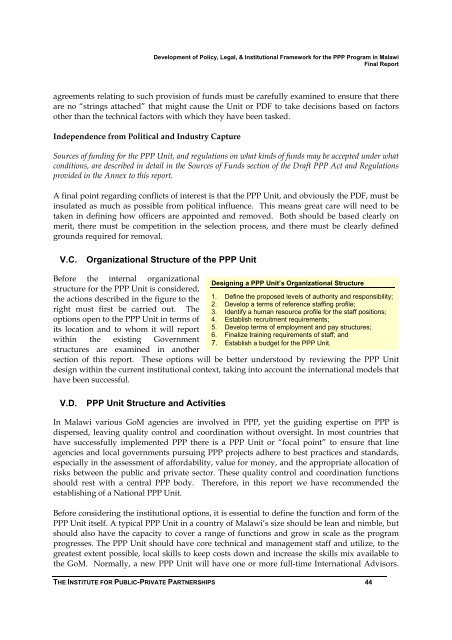Development of Policy, Legal, and Insitutional Framework for - ppiaf
Development of Policy, Legal, and Insitutional Framework for - ppiaf
Development of Policy, Legal, and Insitutional Framework for - ppiaf
You also want an ePaper? Increase the reach of your titles
YUMPU automatically turns print PDFs into web optimized ePapers that Google loves.
<strong>Development</strong> <strong>of</strong> <strong>Policy</strong>, <strong>Legal</strong>, & Institutional <strong>Framework</strong> <strong>for</strong> the PPP Program in Malawi<br />
Final Report<br />
agreements relating to such provision <strong>of</strong> funds must be carefully examined to ensure that there<br />
are no “strings attached” that might cause the Unit or PDF to take decisions based on factors<br />
other than the technical factors with which they have been tasked.<br />
Independence from Political <strong>and</strong> Industry Capture<br />
Sources <strong>of</strong> funding <strong>for</strong> the PPP Unit, <strong>and</strong> regulations on what kinds <strong>of</strong> funds may be accepted under what<br />
conditions, are described in detail in the Sources <strong>of</strong> Funds section <strong>of</strong> the Draft PPP Act <strong>and</strong> Regulations<br />
provided in the Annex to this report.<br />
A final point regarding conflicts <strong>of</strong> interest is that the PPP Unit, <strong>and</strong> obviously the PDF, must be<br />
insulated as much as possible from political influence. This means great care will need to be<br />
taken in defining how <strong>of</strong>ficers are appointed <strong>and</strong> removed. Both should be based clearly on<br />
merit, there must be competition in the selection process, <strong>and</strong> there must be clearly defined<br />
grounds required <strong>for</strong> removal.<br />
V.C.<br />
Organizational Structure <strong>of</strong> the PPP Unit<br />
Be<strong>for</strong>e the internal organizational<br />
structure <strong>for</strong> the PPP Unit is considered,<br />
the actions described in the figure to the<br />
right must first be carried out. The<br />
options open to the PPP Unit in terms <strong>of</strong><br />
its location <strong>and</strong> to whom it will report<br />
within the existing Government<br />
structures are examined in another<br />
Designing a PPP Unit’s Organizational Structure<br />
1. Define the proposed levels <strong>of</strong> authority <strong>and</strong> responsibility;<br />
2. Develop a terms <strong>of</strong> reference staffing pr<strong>of</strong>ile;<br />
3. Identify a human resource pr<strong>of</strong>ile <strong>for</strong> the staff positions;<br />
4. Establish recruitment requirements;<br />
5. Develop terms <strong>of</strong> employment <strong>and</strong> pay structures;<br />
6. Finalize training requirements <strong>of</strong> staff; <strong>and</strong><br />
7. Establish a budget <strong>for</strong> the PPP Unit.<br />
section <strong>of</strong> this report. These options will be better understood by reviewing the PPP Unit<br />
design within the current institutional context, taking into account the international models that<br />
have been successful.<br />
V.D.<br />
PPP Unit Structure <strong>and</strong> Activities<br />
In Malawi various GoM agencies are involved in PPP, yet the guiding expertise on PPP is<br />
dispersed, leaving quality control <strong>and</strong> coordination without oversight. In most countries that<br />
have successfully implemented PPP there is a PPP Unit or “focal point” to ensure that line<br />
agencies <strong>and</strong> local governments pursuing PPP projects adhere to best practices <strong>and</strong> st<strong>and</strong>ards,<br />
especially in the assessment <strong>of</strong> af<strong>for</strong>dability, value <strong>for</strong> money, <strong>and</strong> the appropriate allocation <strong>of</strong><br />
risks between the public <strong>and</strong> private sector. These quality control <strong>and</strong> coordination functions<br />
should rest with a central PPP body. There<strong>for</strong>e, in this report we have recommended the<br />
establishing <strong>of</strong> a National PPP Unit.<br />
Be<strong>for</strong>e considering the institutional options, it is essential to define the function <strong>and</strong> <strong>for</strong>m <strong>of</strong> the<br />
PPP Unit itself. A typical PPP Unit in a country <strong>of</strong> Malawi’s size should be lean <strong>and</strong> nimble, but<br />
should also have the capacity to cover a range <strong>of</strong> functions <strong>and</strong> grow in scale as the program<br />
progresses. The PPP Unit should have core technical <strong>and</strong> management staff <strong>and</strong> utilize, to the<br />
greatest extent possible, local skills to keep costs down <strong>and</strong> increase the skills mix available to<br />
the GoM. Normally, a new PPP Unit will have one or more full-time International Advisors.<br />
THE INSTITUTE FOR PUBLIC-PRIVATE PARTNERSHIPS 44
















